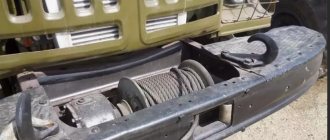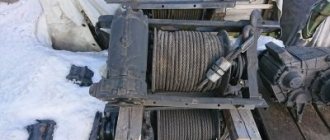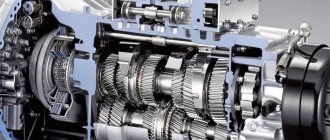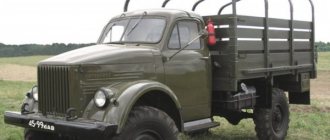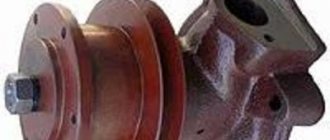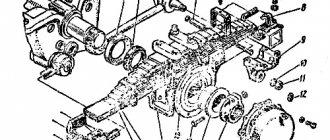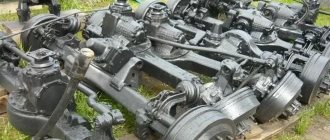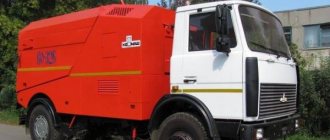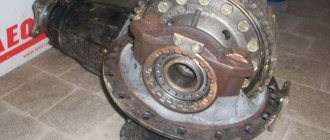content .. 51 52 59 ..
SPECIAL VEHICLE EQUIPMENT
Winch of the ZIL-131N car - part 1
The car is equipped with a winch designed to pull the car out when overcoming difficult sections of the road, as well as to assist other cars stuck along the way.
The winch (Fig. 91) is installed at the front of the vehicle, bolted to the front buffer and front frame cross member. The front buffer is bolted to special removable side member extensions. The winch is driven by a cardan shaft from a power take-off mounted on the gearbox.
The winch drum 12 rotates freely on the shaft and is rigidly connected to the shaft using coupling 3. When the drum engagement fork 4 is moved to the extreme left position, the drum engagement coupling moves on the shaft along two keys and the end cams engage with the end cams of the drum. Fork
The drum switch is installed on the winch traverse. The power fork is equipped with a brake block, hinged in the lugs of the traverse on the axle. When the clutch is disengaged, the brake shoe, under the action of a pressure bolt with a spring, rests against the end of the drum flange, slows down its rotation and prevents the cable from unraveling when unwinding it manually.
The brake is adjusted by tensioning or loosening the spring of the thrust bolt using a nut with a lock nut, and if necessary (when the spring force is insufficient) by moving this bolt by screwing in or unscrewing the threaded bushing. The spring pressure is adjusted correctly if the cable unwinds under hand force without unwinding.
Fig.91. Winch: 1 — drum shaft oiler; 2 — thrust ring of the coupling; 3 - sliding clutch for turning on the drum; 4 — drum activation fork; 5 — front cross member; 6 — guide roller oiler; 7 safety bracket; 8 — guide roller; 9 — cable guide; 10 — winch cable with hook; 11 — winch gearbox; 12 - drum; 13 — drum bearing oiler; 14 — nut of the cable fastening bracket; 15 — cardan shaft; 16 — power take-off control lever; 17 - box. power take-off; 18 — drum brake shoe; 19 — drum fork finger; 20 — rear cross member; 21 — drum shaft traverse
There is a depression on the inner side of the drum flange into which the end of the cable is placed, securing it with a bracket and nuts. Three steel winches, non-unwinding, with a metal core. A hook is attached to the free end of the cable.
The drum shaft rotates in three bronze bearings, two of which are installed in the gearbox housing and one in the traverse. The cross member and gearbox housing are bolted to the cross members.
The drum shaft bearing in the traverse is lubricated through oiler 1. The drum shaft bearings in the gearbox housing are lubricated with oil flowing from the gearbox worm wheel and from the walls of the crankcase cover. The rotation surface of the drum on the shaft is lubricated through two oil nipples 13 located at the drum hubs.
Winch gearbox
(Fig. 92) consists of a globoid single-thread steel worm 25, a worm wheel 3 with a bronze rim, a split crankcase, a drum shaft 7, an automatic brake, bearings and their covers. The worm wheel of the gearbox is mounted on the winch drum shaft on two keys and secured against axial movements with a pin.
The movement of the drum shaft with the worm wheel in the axial direction is carried out by changing the thickness of the set of gaskets under the washer 4 installed between the right end of the gearbox housing and the end of the recess in the cover 6. The washer 4 is attached to the end of the shaft with bolts. In the upper half of the gearbox housing there is an inspection hatch closed with a lid
13. Worm 25 is installed in the gearbox housing 15 on two tapered roller bearings. The bearings are closed with covers 16 and 26. A cuff 21 is pressed into the cover 16. The bearing covers are attached to the gearbox housing with bolts.
At the rear end of the worm shaft there is a drum 17 for the automatic brake of the winch gearbox and a flange 18 for fastening the cardan
bala. The brake drum is mounted on a key, and the flange is mounted on splines: they are secured with a nut against axial movements. The brake drum is covered with a cover.
Fig.92
The cover has a felt cuff 19 that prevents dirt from getting into the brake. Between the end of the inner ring of the bearing and the end of the brake drum hub there is a sealing ring made of copper or paronite. The drum is braked by brake band 9 with a friction lining. One end of the brake band is rigidly fixed in the wall of the bearing cover, and the other is movably fixed in the hole of the cover using a spring. The spring tightens the tape in the direction opposite to the rotation of the worm shaft when winding the winch cable. The tape, under the influence of friction, compresses the spring, which leads to a weakening of the pressure of the tape on the drum, i.e., to a decrease in braking. Due to the rigid fastening of the opposite end of the tape during reverse rotation under the influence of friction, the tape self-tightens, causing the worm to slow down.
At a low rotation speed of the worm shaft, the braking force created by the automatic brake is insignificant and does not prevent the cable from unwinding. In the event of shearing as a result of overload of the safety pin, when the winch drum begins to rotate in the opposite direction at an increased speed, the braking effect becomes significant and serves as an addition to the self-braking action of the worm gear, which prevents rapid rotation of the winch drum and unwinding of the cable.
The brake band tension is adjusted by nut 11. When the nut is rotated clockwise, the spring pressure increases. The brake must be adjusted so that when the cable unwinds, the drum does not heat up excessively.
The winch cable guides are bolted to the lower flanges of the front buffer and the rear cross member of the winch.
At the front, between the guides, there is a guide roller for the winch cable and a rod that keeps the cable from falling out. The roller rotates on an axis secured with nuts in the guides. Lubricate the roller bearings through an oiler installed at the left end of the roller axis.
content .. 51 52 59 ..
Rules for using the winch
In order to ensure reliable and durable operation of the winch, follow the following rules for its operation. To turn on the winch:
- put the gearshift lever in neutral position;
- turn on the sliding clutch 1 (Fig. 1) for turning on the winch drum;
- press the clutch pedal all the way;
- turn on the gear (for winding or unwinding the cable) in box 7 of the power take-off;
- Smoothly release the clutch pedal.
As a rule, you should unwind a free cable
manually, without engaging the gear and turning off the clutch 1 for turning on the winch drum 5.
1 — sliding clutch for turning on the winch drum; 2 — winch drum activation fork; 3 — winch cable with hook: 4 — winch gearbox; 5 — winch drum: 6 — power take-off control lever; 1 - power take-off
To self-extract the car:
- unwind the cable;
- secure the cable to a reliable object (tree, stump, etc.);
- disengage the clutch and engage the gear to wind the cable in the power take-off;
- Engage the clutch and pull up the car At 1000-1100 rpm of the engine crankshaft.
When self-pulling on wet turf roads, it is allowed to engage the drive axles in first gear of the gearbox.
When winching another car, you must put the gearbox shift lever in the central position and brake the car.
After pulling yourself out (or pulling out another car), you must:
- hook the cable hook to the front towing hook;
- disengage the clutch and engage the gear to wind the cable in the power take-off;
- engage the clutch and smoothly pull the cable,
- Place the power take-off control lever in the neutral position.
Rice. 2. Scheme for using a winch using a block:
a - when pulling yourself out, b - to change the direction of thrust when pulling out another car, c - to increase the effort when pulling out another car.
To increase the traction force (over 4500 kgf) during self-pulling, you should use a block (pulley hoist) (Figure 2, a) which should be secured to a stationary object chosen as a support, and the winch cable hook to the front towing hook of the car.
To change the direction (Fig. 2, b) of the thrust when pulling out another car, the block (pulley hoist) is secured to a stationary object that serves as a support, and the hook of the winch cable is hooked to the tow hook of the car being pulled out.
To increase the traction force when pulling out another car (Fig. 2, c), a block (pulley block) is attached to the hook of the car being pulled out, and the hook of the winch cable is attached to a stationary object that serves as a support.
When using a winch it is not allowed:
- traction force on the cable without using a pulley is more than 4500 kgf;
- the working length of the cable is more than 65 m, while at least three to four turns must remain wound on the drum;
- drum rotation speed when winding the cable under load is more than 15-16 rpm,
- the oil temperature in the gearbox during winch operation is more than 130° C;
- The angle of the cable relative to the vehicle axis (in the horizontal plane) is more than 15°. At large angles, use a block (pulley block).
When working with a winch, it is strictly prohibited:
- use the winch cable to tow the car;
- engage the vehicle in reverse gear while the winch is operating;
- be near the cable or between the cables (when using a block) and correct the laying of the cable turns while the winch is operating;
- place bolts or other parts in the hole of the cardan fork instead of a special safety pin;
- change gears while pulling up the car;
- start moving the car with the winch drum disconnected from the shaft.
Winch ZIL
On off-road trucks (ZIL-157, KrAZ-214, Ural-375, etc.) a winch is installed. with the help of which difficult road sections are overcome. evacuate stuck cars, lift and tighten loads.
Winch ZIL
The winch is a drum on which a cable is wound. The drum is mounted on a shaft with a worm wheel that is engaged with the worm. The worm pair is located in the crankcase and is driven from the power take-off using a cardan transmission. The power take-off usually has two working gears for pulling the load and one for unwinding the cable.
Most winches are equipped with an automatic band brake. When the winch drum suddenly rotates under load in the opposite direction, i.e. When the car's clutch is disengaged, the brake band tightens and creates significant resistance to the rotation of the brake drum. The stopping of the drum is facilitated by the self-braking action of the worm pair of the winch.
Winch disassembled
The winches of GAZ-66 vehicles develop a traction force of 3500 kg, ZIL-4500-5000 kg, Ural-375 - 7000 kg, KrAZ-214B-8000 kg. The working length of the winch cable is 55-65 m.
Winch block (polyplast)
Each car with a winch is equipped with a polyplast block. Using this block you can double the power of the winch, since it divides the force in half. When operating a vehicle, the winch cable must always be tightly wound around the drum.
The winch is engaged in the same way as the gearbox. Depress the clutch and engage the PTO in the desired direction and release the clutch. In some cases, it is possible to unwind the cable while the vehicle is moving.
polyplast block
Important when operating the winch
- Do not pull the cable to the very end; the remainder of the cable should be 4 turns of the drum. The working length of the cable is 65 m and the total length is 70 m.
- The oil temperature in the crankcase should not exceed 130 degrees.
- The cable tension should not be more than 45 kN. In other cases, use a pulley block.
- Turn on the PTO transfer case and use your hands to pull the cable tight.
winch diagram zil
Prohibited when using
- It is prohibited to engage reverse gear when the winch is operating.
- When the winch load is heavy, speed gears cannot be engaged.
- Do not tow another vehicle with a winch.
- When the winch is operating, it is prohibited to stand near the cable or align the cable in the winch drum.
- If the winch overheats in the gearbox gears, it is necessary to stop work and find the cause of the overheating.
worm gear
Winch Maintenance
A timely inspection of all parts is carried out, bearing bolts are tightened, oil is changed, oil seals are checked, and gear mesh is adjusted.
It is necessary to periodically lubricate the articulated joints of the propeller shaft and the winch drum shaft.
When a gap appears in the worm pair, adjust the bearings or change the mechanism.
The tapered bearings of the worm are adjusted by paper shims under the cover.
The contact patch engagement adjustment is determined by applying paint to the engagement teeth. The gearbox will heat up if the contact patch is not properly engaged.
WATCH THE VIDEO
Power take-off
Installed on the gearbox, there is a hatch on the right side for installation. PTO with reverse, turns in both directions. The PTO consists of a gearbox housing, a gear block, a main shaft, a gear axis, a shift fork, 2 ball bearings, and a flange. The PTO gear rotates from the rear speed of the gearbox. When installing the PTO, the shafts should rotate freely without snagging the gears, turning them by hand. The shaft is adjusted by a set of paper shims under the bearing cap. The maintenance of the PTO gearbox is the same as that of the gearbox.
power take-off box
Maintenance and repair
Maintenance and repair of the ZIL-131 should only be carried out with the engine turned off and at a special site.
Reasons why repair work is required:
- The engine gets very hot and the muffler fires.
- Resource exhaustion, which causes the crankshaft, cylinder block, transmission and other main components of the car to fail.
- Burnout of the piston device.
- The presence of damage and cracks on the engine housing, gearbox and cylinder block.
- Short circuit or open circuit.
Maintenance involves replacing the oil fluid, external inspection of units and replacing consumables.
Why it won't start and what to do
The power unit may not start due to a lack of fuel in the system, a stuck air throttle valve, or clogged jets.
In order to repair the engine, you must:
- Blow out the fuel lines.
- Check the functionality of the needle valve located on the carburetor.
- Inspect the fuel pump for defects and damage.
- Blow out cylindrical elements.
- Crank the engine using an electric starter with the throttle valves fully open.
- Check the operation of the air damper.
- Wash the jets with acetone and blow through with air.
Carburetor adjustment
With a properly adjusted carburetor, the throttles and choke valves will open and close in response to the position of the brake pedal.
Carburetor adjustment takes place in several stages. First, the manual and foot drive of the throttles are adjusted, only after that they move on to setting the air damper.
The foot-type drive is adjusted using a threaded fork, and the manual drive is adjusted using a clamp that is installed on the end of the drive cable.
At low engine idle speeds, vacuum from the intake manifold is transmitted through the opening of the idle system, after which the working fluid enters the lubrication system.
How to set the ignition
In order to set the ignition on a ZIL, you must perform the following steps:
- Set the piston mechanism of cylinder number 1 to the top dead center position.
- Rotate the crankshaft until the hole on the crankshaft pulley aligns with the top dead center mark.
- Position the groove on the distributor drive shaft.
- Insert the drive into the slot of the block.
- Rotate the crankshaft to the installation angle.
- Remove the mounting bolt from the plate.
- Turn on the ignition.
- Rotate the switchgear housing into the drive socket.
- Check that the wires on all cylinders are installed correctly.
Clutch adjustment
Clutch adjustment is carried out in several stages. The first step is to adjust the free play of the clutch pedal. To do this you need:
- Measure the stroke from the center of the plate to the mechanism.
- Lower the pedal all the way.
- Connect the lever to the top eye of the pusher using an eccentric pin.
- Tighten the castle nut.
At the second stage, it is necessary to debug the clutch stroke. Its free play should not exceed 4 mm. Adjustment is carried out using a spherical nut.
At the last stage, you need to adjust the full stroke of the hydraulic power steering pusher.
